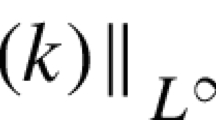Abstract
We derive an equation satisfied by the dissipation rate correlation function, \(\left\langle {\varepsilon (\vec x + \vec r,t + \tau )\varepsilon (\vec x,t)} \right\rangle \) for the homogeneous, isotropic state of fully-developed turbulence from the the Navier–Stokes equation. In the equal time limit we show that the equation leads directly to two intermittency exponents μ 1=2−ζ 6 and μ 2=z″4−ζ 4, where the ζ's are exponents of velocity structure functions and z″4 is a dynamical exponent characterizing the fourth order structure function. We discuss the contributions of the pressure terms to the equation and the consequences of hyperscaling.
Similar content being viewed by others
REFERENCES
U. Frisch, Turbulence (Cambridge, New York, 1995).
A. S. Monin and A. M. Yaglom, Statistical Fluid Mechanics: Mechanics of Turbulence (MIT Press, Cambridge, 1975).
M. Nelkin, Adv. Phys. 43:143-181 (1994).
G. Stolovitzky and K. R. Sreenivasan, Rev. Mod. Phys. 66:229-240 (1994).
K. R. Sreenivasan and P. Kailasanath, Phys. Fluids A 5:512-513 (1993).
The spatio-temporal behavior of S2(r,τ) was considered through an exact equation in S. Chandrasekhar, Proc. Roy. Soc. (London) 229:1(1955).
F. Hayot and C. Jayaprakash, Phys. of Fluids 12:327-335 (2000).
L. D. Landau and E. M. Lifshitz, Fluid Mechanics (Pergamon, New York, 1986); note the neglect of the term νd2 S2/dr2 in the inertial range on p. 140.
See p. 43 of Frisch in ref. 1.
V. S. L'vov, E. Podivilov, and I. Procaccia, Phys. Rev. E 55:7030-7035 (1997).
F. Hayot and C. Jayaprakash, Phys. Rev. E 56:227(1997) where the τ=0 limit of dynamical structure functions was considered.
H. Tennekes, J. Fluid Mech. 67:561-567 (1975).
See, M. E. Fisher, in Collective Properties of Physical Systems, B. Lundqvist and S. Lundqvist, eds. (Academic, N.Y., 1974), p. 23.
M. Nelkin and T. L. Bell, Phys. Rev. A 17:363-369 (1978). See also, U. Frisch, P.-L. Sulem, and M. Nelkin, J. Fluid Mech. 87:719-736 (1978).
V. L'vov and I. Procaccia, Phys. Rev. Lett. 76:2898-2901 (1996);V. L'vov and I. Procaccia Phys. Rev. E 53: 3468-3490 (1995); V. L'vov and I. Procaccia Phys. Rev. Lett. 77:3541–44 (1996).
Author information
Authors and Affiliations
Rights and permissions
About this article
Cite this article
Jayaprakash, C., Hayot, F. An Equation for the Dissipation Rate Correlation and Its Implications for the Intermittency Exponent μ in Turbulence. Journal of Statistical Physics 111, 371–386 (2003). https://doi.org/10.1023/A:1022269427387
Issue Date:
DOI: https://doi.org/10.1023/A:1022269427387




